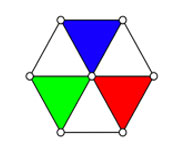


 تاريخ الرياضيات
تاريخ الرياضيات
 الرياضيات في الحضارات المختلفة
الرياضيات في الحضارات المختلفة 
 الرياضيات المتقطعة
الرياضيات المتقطعة
 الجبر
الجبر
 الهندسة
الهندسة 
 المعادلات التفاضلية و التكاملية
المعادلات التفاضلية و التكاملية 
 التحليل
التحليل
 علماء الرياضيات
علماء الرياضيات |
Read More
Date: 16-8-2017
Date: 27-7-2017
Date: 27-7-2017
|
Died: 1973 in Egypt
Mohammed Reda Madwar attended French School in both Egypt and Paris and received the "French baccalaureat". This exempted him from sitting the Preliminary Examination for the University of Edinburgh in Scotland and his first matriculation there was in October 1914. On his matriculation form he gave his home address as Custom House, Alexandria, Egypt, and his Edinburgh address as Rosehill, Corstorphine. He entered the Department of Engineering to study for a degree in Applied Science.
Madwar's university studies at the University of Edinburgh included courses in Chemistry (taught by Dr Dobbin), Natural Philosophy (taught by Dr Carse and Dr Barkla), and Mathematics (taught by Dr Horsburgh) in session 1914-15. In the following year he studied Applied Mathematics (taught by Dr Knott), Geology, Junior Drawing, Heat engines, and Engineering. He was awarded the degree of Bachelor of Science with Honours in Civil Engineering on 11 July 1917. He won two medals during his studies at Edinburgh. He then continued to live in Edinburgh, working for the year 1918-19 as an assistant engineer for Lesly Co. After a further year in Great Britain as a scientific assistant at the Royal Aviation Inst., Madwar returned to Egypt in 1919.
Back in Egypt, Madwar worked as an Irrigation Engineer at the Ministry of Public Works for three years, then spent one further year as a scientific assistant in the Physical Department of the Ministry of Public Works. He was then awarded a scholarship which enabled him to return to Scotland to study for his doctorate at the University of Edinburgh. He joined the Edinburgh Mathematical Society in December 1925. After three years undertaking research in astronomy, Madwar was awarded his Ph.D. by Edinburgh University in 1926. Following the award of his doctorate, Madwar returned to Egypt where he was appointed as Permanent Observer at the Royal Helwan Observatory. He held this post until 1934 where he became the first Egyptian Director of Helwan Observatory. Two years later, in 1936, in addition to his directorship of the Observatory, he was appointed as Professor of Astronomy at Cairo University. In 1953 he retired from his position at the Royal Helwan Observatory and at the same time became Professor Emeritus of Astronomy at Faculty of Science, Cairo University.
Madwar's achievements in his roles at the university and the observatory are substantial. He installed the Transit Telescope at Helwan Observatory for the determination of Astronomical times, he participated on behalf of Helwan Observatory in the Discovery of Pluto in 1930, he established the Astronomy Department in the Faculty of Science at Cairo University in 1936, and he headed the Egyptian mission of the Total Solar Eclipse at Khartoum in 1952:-
In the late forties, the ex-king of Egypt, Farouk, visited Helwan observatory. He acknowledged the efforts of Professor Madwar and his research work in discovering the Planet Pluto and some galaxies using the 30" reflector of Helwan Observatory. He asked Professor Madwar to prepare himself for the ministry in the next change. Professor Madwar apologized gently, and instead he asked the king for funds to build a bigger telescope. The king agreed immediately and Cairo University gave about half a million Egyptian pounds for this project (at that time the Astronomy Department and Helwan Observatory belonged to Cairo University as a single entity, the "Institute of Astronomy"). Professor Madwar started the site testing and signed the agreement with an English company to build the 74" reflector telescope for the Kottamia Observatory.
He prepared the feasibility study for establishing Kottamia Observatory and singed the agreement with the Grupp-Parsons Corporation to install the 74 inch telescope.
He received many honours for his contributions. In 1926 he became an Associate member of the Royal Civil Engineering Society and in the following year was elected to the Royal Society of London and the Royal Society of Edinburgh. He was elected to the RSE on 14 March 1927 having been proposed by Ralph Allan Sampson, Sir Thomas Hudson Beare, Charles Glover Barkla, and Sir Edmund T Whittaker. He was awarded the State Prize of Appreciation (1966) and the State Medal (First Class Honour) (1968). He became a member of the Egyptian Scientific Compound (1940), a member of the International Astronomical Union, chairman of the International Union of Geodesy and Geophysics, president of the Egyptian Academy of Sciences, and chairman of the Egyptian Mathematical and Physical Society.



|
|
|
|
التوتر والسرطان.. علماء يحذرون من "صلة خطيرة"
|
|
|
|
|
|
|
مرآة السيارة: مدى دقة عكسها للصورة الصحيحة
|
|
|
|
|
|
|
نحو شراكة وطنية متكاملة.. الأمين العام للعتبة الحسينية يبحث مع وكيل وزارة الخارجية آفاق التعاون المؤسسي
|
|
|